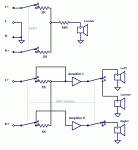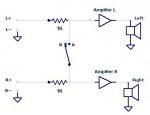I have a decent ($200) center channel speaker I want to use as a mono reference for my mixes. It has one + and one - terminal. I'm going to use a speaker switch box to switch between various sets of speakers, so I will have L+ L- and R+ R- terminals coming out of the switchbox. Is there a correct way to hook this up?
Thanks for any replys.
Thanks for any replys.

 (I got a message that my PM Inbox was full, so I looked around and found your thread.)
(I got a message that my PM Inbox was full, so I looked around and found your thread.)

 ) can make it near impossible to hear a flat summed response. Mono from a single speaker is really the best way to go.
) can make it near impossible to hear a flat summed response. Mono from a single speaker is really the best way to go.